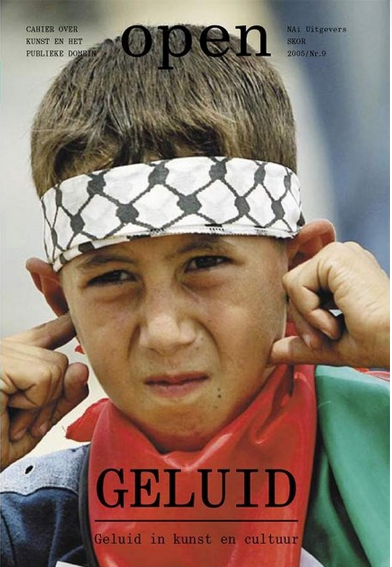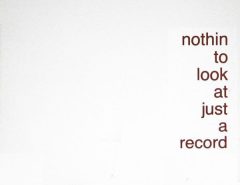
La Foundation for art and public domain dedicó en 2005 este séptimo número de la revista open al sonido y el arte. Todos los artículos están on-line, en inglés y holandés.
Public space is not only visually but also acoustically manifest: public nature is a function of visibility and audibility.
Including the role of sound in reflections on public space and in its actual design is therefore as necessary as considering the visual. In n0. 9 there are essays about the way in which sound and audio media play an aesthetic, ethical or political role in contemporary urban space. This issue illustrates how radio is undergoing a veritable cultural and artistic revival and how sound is deployed in art in relation to social or spatial surroundings. This issue presents work by international artists and also includes an mp3 disc with sonic artworks and interviews.Jorinde Seijdel
Editorial
Online article
Jonathan Sterne
Urban Media and the Politics of Sound Space
Online articleMuzak, also known as ‘nonaggressive music deterrent’, is used more and more often as a strategic weapon in the effort to make public space ‘safe’ and controllable. But according to Jonathan Sterne, its use is primarily aimed at excluding non-consumers – whereas he believes it should be seen as a vital component of urban design. In Sterne’s opinion, besides an aesthetical dimension, sound also has a political and ethical dimension.
Alex de Jong and Marc Schuilenburg
The Audio-Hallucinatory Spheres of the City
A Pop Analysis of the Urbanization Process
Online articleUnder the name Studio Popcorn, architect Alex de Jong and jurist-philosopher Marc Schuilenburg research the effects of urbanization processes. They argue for the inclusion of processes other than physical, spatial ones in the scope of research on urbanization. This article focuses on the rise of an intermedial space, which includes contemporary popular music and its associated urban culture, and which plays a crucial part in today’s urbanization processes.
Caroline Bassett
‘How Many Movements?’1
Mobile Telephones and Transformations in Urban Space
Online articleMobile telephones create aural space that is both technological and imaginary. Caroline Basset explores the new spatial economy that is the result of the dynamics between physical and virtual space, between old and new space. Fragmentation and individualization are not her primary findings. Rather, according to Basset, the changing dialectics of presence/absence also generate new types of connectedness and continuity, of mobile subjectivity.
Brigitte van der Sande
Setting Limits and Overstepping Limits
Concerning Moniek Toebosch’s Work
Online articleImage and sound in Moniek Toebosch’s oeuvre are like Siamese twins; even in projects which seem initially to consist solely of sound, the surrounding countryside may for instance serve to heighten the experience of the sound. Loudspeakers are never deployed neutrally, but are presented in a dramatic setting. Brigitte van der Sande spoke to her about art, sound and open space, about overstepping limits in cultural institutions and setting limits for art in public space.
Dirk van Weelden
The Multiplication of the Street
New Impulses for Radio
Online articleRadio demonstrated all too often in the past how the community spirit could be stirred and feelings of loneliness and isolation dissolved, according to Dirk van Weelden. Today developments in mobile telephony are providing the medium of radio with a new stimulus. If the network is linked to the city’s physical reality this can stretch the significance of the public realm considerably.
Siebe Thissen
Column ‘Listen and Learn’
Online articleUlrich Loock
Times Square
Max Neuhaus’s Sound Work in New York City
Online articleFrom now on, the editors of Open will (re)focus attention on an existing work of art in public space. Max Neuhaus’s Sound Work was first installed on Times Square in 1977. It ceased to function in 1992. In 2002 the Dia Art Foundation restored this work of art and included it in their collection. Ulrich Loock analyses the work and describes how Neuman separates sound from the dimension of time. Without being visually or materially present, Neuhaus creates what he calls an individual and authentic experience of place.
Mark Bain
Psychosonics, and the Modulation of Public Space
On Subversive Sonic Techniques
Online articleArtist Mark Bain’s work focuses on the interaction between sound, architecture and public space. Triggered by the emergence of new sound techniques for crowd control, he reflects on ‘psychosonics as an invisible tactile material to provoke a public’, using William Burroughs’ ‘audio virusses’ and his own sound art as points of reference.
LIGNA
The Future of Radio Art
A Monologue for a Broadcast Voice
Online articleDial the Signals!
Radio Concert for 144 Mobile Phones
Online articleHuib Haye van der Werf
Radiodays
An Enquiry into Aural Space
Online articleThe editors of Open asked Huib Haye van der Werf, one of the participators of the tenth Curatorial Training Programme (ctp) of De Appel Foundation in
Amsterdam, to write a review of the project Radiodays that took place in April 2005.1 The description of various projects sheds light on the reason why the curators in training chose radio as the medium, and also on the selection of the artists and the type of contribution.Amy Plant
Valley Vibes
A New Way to Read an Area
Online articleJeanne van Heeswijk and Amy Plant started Valley Vibes in 1998, in association with chora, a research institute for architecture, landscape and urbanism. For four years, the inhabitants of an urban regeneration district in East London were given the opportunity to record, mix and broadcast the sounds of their events using the Vibe Detector. This registration of sound can be seen as a ‘journey’ through the district. The following is a description of the project and a selection of the logbook entries.
The mp3 disc presents work by Moniek Toebosch, Mark Bain and LIGNA. It also includes a special compilation of radio from the art project Radiodays: Huib Haye van der Werf selected interviews with Hans Ulrich Obrist and Suchan Kinoshita, as well as radio programmes by Raul Keller, Guy van Belle & Bojan Fajfric, Derek Holzer & Sara Kolster, Lise Brenner, James Beckett and LIGNA.
Bookreviews by Jennifer Allen, Mariska van den Berg, Maarten Delbeke, Paul Groot, Omar Muñoz Cremers, Wieteke van Zeil
Online bookreviews





Leave a Reply
Lo siento, debes estar conectado para publicar un comentario.